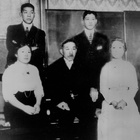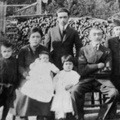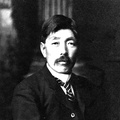
When Sumio Ishidate wrote about early Victoria in 1909, he had claimed, “In the autumn of the 17th year of Meiji (1884), several Japanese landed at Victoria . . . Kisuke Mikuni and Tomekichi Homma who live in Vancouver district are people who came during that period.” Like Homma, Mikuni never claimed in his lifetime that he was the first immigrant. Of course, as we have seen, neither did Nagano.
Of the two men Ishidate named as arriving in Victoria in 1884, he was incorrect about Homma as demonstrated. The other, Kisuke Mikuni is the real “first pioneer” who came to sink his roots deep into the soil of Canada.
His life in Canada was one of enterprise and adventure, taking him from shop clerk in Victoria to a mine supervisor, to farmer, contractor, labour negotiator, and shipper of charcoal and cordwood. He helped countless Japanese immigrants settle into their new country of Canada. Yet Kisuke Mikuni is unknown even to most experts in Japanese Canadian history. Despite this, he deserves prominence as the first known immigrant coming from Japan to settle in Canada permanently.
Nakayama wrote about Mikuni in his work of 1921:
Mikuni hailed from Okayama Prefecture. He resolved at an early age to travel abroad and quietly awaited his opportunity while frequenting the foreign trading houses of Kobe and Yokohama.
He won, by chance, the friendship of Charles Gabriel, of a Yokohama trading firm and was repeatedly advised by the latter to travel to Canada, as a country of future promise, Mikuni accordingly seized the opportunity when it arose and followed Gabriel to Victoria, opening a Japanese store in the city... However, there were only one or two fellow Japanese in Victoria at the time and Mikuni’s life must have been an exceedingly lonely one.1
Charles Gabriel, a businessman and entrepreneur in Victoria, was the key to Mikuni’s life in Canada. Son of a French mother and a Spanish father, he spoke fluent Japanese. Before moving to Victoria he lived in Yokohama, where he learned the language. Arriving in Victoria about 1882 with a wife and son, he engaged in wholesale trade and insurance.
The next year he found himself acting as unofficial Japanese consul when twelve shipwrecked Japanese sailors landed in Victoria in March of 1883.2 With his knowledge of Japanese, Gabriel was able to assist the sailors to return home. The next year, Gabriel traveled back to Yokohama to gather goods for a store he planned to open in Victoria. He met Mikuni on that occasion and persuaded Mikuni to join him in Victoria and help run the store.
Again, Nakayama wrote:
Around 17th or 18th year of Meiji [1884], a French merchant, Charles Gabriel, who dealt with Japanese merchandise, kindly took care of Japanese immigrants such as…Mikuni Kisuke, Tamura Shinkichi, and Shino Arimichi. While they were working hard under Mr. Gabriel, a coal deposit was found in Tumbo Island, and Mr. Gabriel sent Mr. Mikuni back to Japan to recruit over 20 coal miners from Takashima Coal Mining Company...Mr. Gabriel was very helpful to Japanese immigrants and he was the guarantor and protector for those immigrants.3
What other evidence have we that Mikuni, or any Japanese for that matter, were living in Victoria by 1884?
Gabriel’s Japanese Bazaar opened in time for Christmas 1884 on Government Street. A few months later, The Daily British Colonist carried a short item about a court case brought by Charles Gabriel against a Japanese man, Ischia Gama [sic]. Gabriel alleged Gama was a vagrant who harassed his Japanese employees—implying that he had two or more Japanese working for him.4

Like any store owner, Gabriel kept accounts in a ledger, and we are fortunate that the ledger has been preserved in the BC Archives.5 Kisuke Mikuni and eight other Japanese names appear in its pages. The “Japanese Mess” is tallied at $118 in 1886—signifying a sizeable group of hungry clerks being fed at Gabriel’s expense.
In fact some of them boarded in his six-room house at 33 South Park Street.6 It is still standing in the same location, but the address is now 865 Academy Close.

In November 1886 two men told Gabriel about a coal deposit they had discovered on Tumbo Island, located off the north-east end of Saturna Island near the US border, worth at least $25,000. Gabriel was intrigued. To check it out, he sent Mikuni as his trusted deputy over to Tumbo. Gabriel was convinced, but he needed two things: capital and miners. He took off to eastern Canada to raise the money. In January 1887 Gabriel sent Mikuni to Japan to recruit miners from Kyushu—another indication of Gabriel’s trust in him. Mikuni returned with about 20 seasoned miners.7
Gabriel left the shop to be run by his clerks and built a house on Tumbo Island to be near his new operation. Mikuni moved over with him, as interpreter for the miners and supervisor when Gabriel was away. In the 1891 Canada Census, Mikuni is listed as “interpreter,” as part of Gabriel’s household.
The Tumbo mine became both Gabriel’s undoing and Mikuni’s opportunity. From the start, workers proved difficult to manage. In addition, the first shaft drilled filled with water and a boiler explosion killed two workers. Then, Gabriel lost his only son in a drowning accident during a family outing. Gabriel eventually gave up and sold out. He and his wife left British Columbia, dropped out of sight, and possibly travelled to Japan to start fresh with another enterprise.8
As for Kisuke Mikuni, his adventures had only begun. Taking a liking to the rural lifestyle, he purchased land at Winter Cove on Saturna Island, built himself a log house, and did some farming.9 His boathouse remains, overlooking the cove and a projection of land now known as Mikuni Point.10 He also cut cordwood, and added value to the wood by getting it made into charcoal for use in the salmon canneries.
As reported in The Daily Colonist:
Tug Eva took away two scowloads of cordwood from Little Canoe Pass on Thursday, for use in the new cannery on Lulu Island. Mr. Mikuni, the shipper, has also been successful in the making of charcoal, and has been able to supply quite a number of canneries this summer.11
In 1894 Mikuni formalized his loyalty to Canada by becoming a British subject. After being confirmed as a worthy person by a witness (a routine step), he swore an oath of residence and allegiance.12 Finally on Feb. 1, he received his certificate of naturalization, listed as a farmer, Saturna Island. In 1898 he appeared on the Voters List for Saturna Island.13
Within a year Mikuni moved off Saturna Island to take up a timber licence on a quarter section of land up the north arm of Burrard Inlet. He planned to apply for and establish a homestead on the property after clearing it of timber. The records of the Department of the Interior, Dominion Lands Branch, contain a letter Mikuni wrote to that effect, in 1905, expressing a wish to establish a homestead with “fruit orchard and chicken yard.” In that letter Mikuni declared he had been in Canada for 20 years, since at least 1885.14
By the turn of the century, Japanese fishermen on the Fraser River and elsewhere numbered in the thousands. The cannery bosses tried to pay as little as possible for the delivery of fish. In June 1900, the newly formed Japanese Fishermen’s Association commissioned Mikuni to help negotiate on their behalf for better prices for their fish. An agreement was eventually reached after a bitter strike, and the fishermen were able to start the season in late July.15
Mikuni did not confine his ventures to fish and charcoal. Knowing that the burgeoning railway and other construction were in need of raw materials, he operated a rock quarry on Howe Sound, shipping gravel from there by scow to for the new C.P.R. docks in Vancouver.16

Around the turn of the century, now in his mid-40s, Kisuke Mikuni found his true love, Sano Fujiwara, in New Westminster, where he settled. Sano was a widow with two teenage children, a boy, Asajiro (or Arthur) 17, and a younger girl. In a few years, Mikuni’s stepson became his partner in a number of business ventures: a rice mill and store, and some real-estate development.17 At age 23, in 1907, Arthur was sent to Japan to get married in his mother’s prefecture, and he brought his bride Tsuru home to Canada. Eventually they had five children; today their descendants live in Ontario.18
Unfortunately Kisuke Mikuni was not able to enjoy his grandchildren. On May 21, 1909, at age 54, he died of heart disease. At the time of his death, his wife was back in Japan, probably looking after her daughter’s marriage prospects. It was about a month before Mikuni’s will was located. It included the name of his executor, Paul Okamura, a well-known New Westminster photographer.
From the probate court documents we learn something about Mikuni’s assets, which included interest in real estate, shingle bolts, stocks, and some cash.19 He was not wealthy, but one could say he did well. He left his estate in the hands of his stepson Asajiro, with the stipulation that he support his mother, Sano. She lived on 30 more years, and died at age 79 in 1939. Sano is buried next to her husband under a huge granite obelisk in Mountain View Cemetery in Vancouver.
Mikuni, not Nagano or Homma, was the First Japanese Immigrant
There are no documented reports of any Japanese in Victoria or any other part of Canada before the years 1884-5. The first confirmed Japanese living in Victoria were clerks working for Gabriel. Mikuni was the first clerk Gabriel met and hired from Japan, in 1884. The other men hired as clerks came later than Mikuni and eventually most went back to Japan. Evidence suggests that Manzo Nagano came to Canada in 1892, not in 1877; while Homma claimed in 1922 that he had come in 1889. In spite of his claim, because there are so many inconsistencies in the dates related to Homma, it is possible he might have arrived two years earlier, but no earlier than 1887, and certainly not in 1883.
Then, why is Mikuni not better known? He died at an early age, and he spun no tall tales of his doings. He went quietly about his activities, moving through diverse enterprises, from mining supervisor to contractor, farmer, logger and more. Above all, he reached out to assist other immigrants, and with his good command of English, helped ease them into their new country. His friend Shinkichi Tamura became a banker. Yasushi Yamazaki, whom he befriended early on and worked with in the contracting business, became president of Canadian Japanese Association in Vancouver, founded the newspaper Tairiku Nippo and was leader of the Japanese Canadian Volunteer Corps in 1916.
Jinshiro Nakayama provides us with an eloquent final tribute to Kisuke Mikuni in his 1921 book: Kanada Doho Hatten Taikan.
He was an extremely cheerful and generous man and was kind to the point of forgetting to eat and sleep in providing guidance to those who followed him. It is no exaggeration to say that there is not one highly successful man in Vancouver or across Canada who did not receive his help or recommendations. An adventurous and intrepid spirit was the hallmark of his personality and once he embarked on a project, his perseverance allowed no adversity to stand in his way. He became particularly proficient in English and his conversational style was quite skilled. It is indeed difficult to imagine what more he might have accomplished had he been granted another decade of life and his death is much to be deplored.
Translated by Howard Katz.
Notes:
1. Jinshiro Nakayama, Kanada Doho Hatten Taikan: Furoku, Vancouver, B.C., 1922, pp. 133-137.
2. The Daily Colonist, Victoria, April 13,1883.
3. Nakayama, 133-137.
4. The Daily Colonist, Victoria, March 25, 1885.
5. “Petty Ledger Book of Charles Gabriel & Co., Victoria merchants 1884-90,” B.C. Archives, Royal B.C. Museum, Victoria.
6. “S. Tamura at 33 South Park” in 1890, Henderson’s City Directory.
7. Nakayama, 133-137.
8. Marie Elliot, “Coal Mining on Tumbo Is.”, manuscript at the B.C. Archives. (Also Nakayamastates Gabriel went back to Yokohama.)
9. A Gulf Island Patchwork, Gulf Islands Branch, B.C. Historical Association, 1969, pp. 57-58. (Mikuni’s house was later bought by another resident, Gilbert H. Anslie, and eventually it wasmoved to South Pender Island, renovated into a church, and, finally, it reverted back into aprivate dwelling. Coincidentally, his boathouse, still sitting on the beach, was also convert to a church. According to his death certificate, Mikuni himself was a Buddhist.)
10. “Mikuni Point”, Official Name. Feature Type: Point ... Gazetteer Map: 92B/14. Relative Location: N.W. side of Saturna Island, Cowichan Land District...www.env.gov.bc.ca/bcgn-bin/beg10?name=23593.
11. The Daily Colonist, Victoria, August 30, 1893. The remains of charcoal pits have been discoveredon several of the Gulf Islands: Mayne, Galiano and Saltspring, remnants of the occupationof Japanese.
12. B.C. County Court (Victoria), Naturalization applications and oaths of allegiance, 1859-1917, B.C. Archives, Royal B.C. Museum.
13. Sessional Papers of the British Columbia Government, 1899: “Kisuke Mikuni, Saturna Island, Farmer.”
14. “Correspondence relating to land settlement in the Rail Road belt and the Peace River Block, 1885-1949”, B.C. Provincial Archives, Royal B.C. Museum.
15. The Daily Colonist, Victoria, June 19, 1901.
16. Sumio Ishidate, Kanada Doho Hatten-Shi, Vol.1, Vancouver, B.C.: Tairiku Nippo Sha, 1909.
17. In 1908 Asajiro and Kisuke applied for a plumbing permit on property on Columbia Street; and N.W.M./A Building File, Water Connection Record, 20-12-1908 and 10-12-1908, New Westminster Archives.
18. In 2015 we contacted descendants of the Fujiwara family in Ontario; they were extremely helpful in providing information and photographs of the Mikuni family.
19. Succession Duty Act, Victoria, court document, June 5, 1909 in “Probate Records, B.C. Supreme New Westminster, 1881-1943”, microfilm, B.C. Provincial Archives, Royal B.C. Museum, Victoria.
*This article was originally published in the Nikkei Images, A publication of the Nikkei National Museum & Cultural Centre (Volume 28, No. 1).
© 2023 Ann-Lee Switzer, Gordon Switzer







